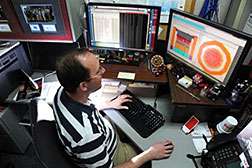INL nuclear engineer John Bess helped analyze a new French fast reactor design.
The world's nuclear experts have reached out to U.S. Department of Energy engineers for help evaluating a new nuclear reactor design that could increase safety margins while reducing waste.
The project marked a series of firsts for nuclear engineers on both sides of the Atlantic. They fostered a new collaboration and tapped state-of-the-art analysis tools to evaluate a first-of-a-kind reactor design.
France's Atomic Energy and Alternative Energies Commission (CEA) collaborated with nuclear engineers at DOE's Idaho National Laboratory and Argonne National Laboratory for the project. Its goal: assess safety and performance parameters for a new fast reactor design.
The Advanced Sodium Technological Reactor for Industrial Demonstration (ASTRID) is intended to significantly improve resource utilization, potentially produce less radioactive waste, and increase safety margins compared to current technology. The design offers inherent protection because the fission process would slow down naturally even if the reactor shutdown capability is lost, and passive decay heat removal systems would keep the reactor core cool.
Before such a reactor can be built, those safety assumptions need to be checked and rechecked. That's where the DOE national labs come in. The effort used cutting-edge analysis tools, and the findings verified French predictions while highlighting where to focus future efforts.
"We have tools and data today that we didn't have 15 years ago," said INL Fellow Giuseppe Palmiotti, who led the lab's contribution. "Plus, this enabled young American engineers to evaluate a unique design with a promising outlook."
Provided by US Department of Energy























